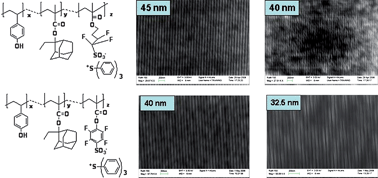Novel chemically amplified resists incorporating anionic photoacid generator functional groups for sub-50-nm half-pitch lithography
Abstract
A series of chemically amplified resists based on

* Corresponding authors
a Polymer Nanotechnology Laboratory at Center for Optoelectronic and Optical Communications, Department of Chemistry, University of North Carolina, Charlotte, North Carolina, USA
b School of Chemical & Biomolecular Engineering, Georgia Institute of Technology, AtlantaGeorgia, USA
c Intel Corp., Hillsboro, OR, USA
d
Lab. de Nanotecnologia e Ingenieria Molecular, Area de Electroquimica, Depto. de Quimica, CBI, Universidad Autonoma Metropolitana– Iztapalapa, Delegacion Iztapalapa, Av. San Rafael Atlixco No. 186, Col. Vicentina C.P., Mexico, DF
E-mail:
kegonsal@uncc.edu
Fax: +1 (01)704 687 8241
A series of chemically amplified resists based on

 Please wait while we load your content...
Something went wrong. Try again?
Please wait while we load your content...
Something went wrong. Try again?
K. E. Gonsalves, M. Wang, C. Lee, W. Yueh, M. Tapia-Tapia, N. Batina and C. L. Henderson, J. Mater. Chem., 2009, 19, 2797 DOI: 10.1039/B818612J
To request permission to reproduce material from this article, please go to the Copyright Clearance Center request page.
If you are an author contributing to an RSC publication, you do not need to request permission provided correct acknowledgement is given.
If you are the author of this article, you do not need to request permission to reproduce figures and diagrams provided correct acknowledgement is given. If you want to reproduce the whole article in a third-party publication (excluding your thesis/dissertation for which permission is not required) please go to the Copyright Clearance Center request page.
Read more about how to correctly acknowledge RSC content.
 Fetching data from CrossRef.
Fetching data from CrossRef.
This may take some time to load.
Loading related content
